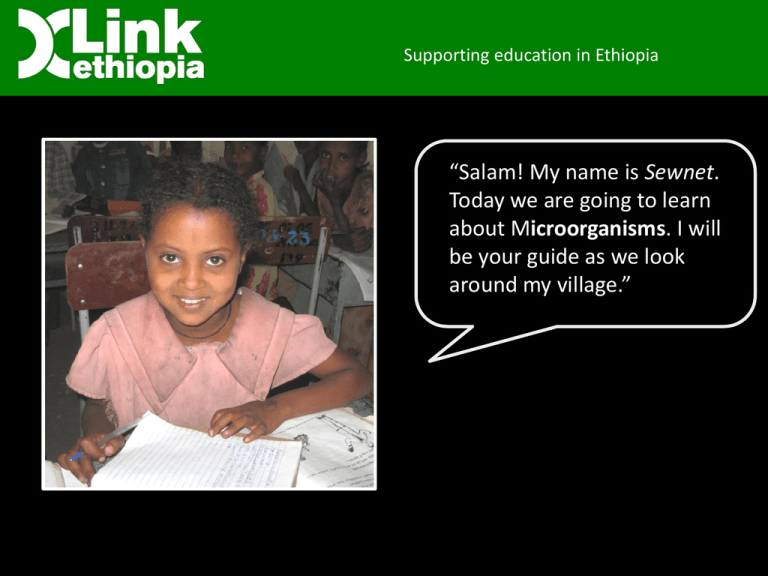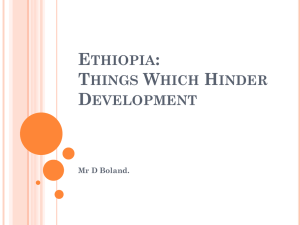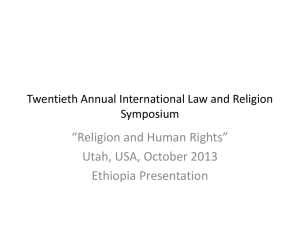Microorganisms - Power Point - News
advertisement

Supporting education in Ethiopia “Salam! My name is Sewnet. Today we are going to learn about Microorganisms. I will be your guide as we look around my village.” Supporting education in Ethiopia What is a Microorganism? Microorganisms are very tiny living things. They are so small that you need a microscope to see them. Microorganisms are all around us, in the air, in our bodies and in water. Some microorganisms are harmful to us, but others are helpful to us. There are three types of microorganism: • viruses • bacteria • fungi Supporting education in Ethiopia Harmful Microorganisms Some microorganisms can harm us. Bacteria and viruses, often called germs, can cause disease. This is a type of bacteria called ‘Streptococcus’ which commonly causes sore throats. This is an example of a virus which causes the common cold. Supporting education in Ethiopia Bacteria and viruses can also cause diarrhea and upset stomachs. They can be easily transmitted if people do not wash their hands after going to the toilet. “At my school, many children used to get sick because we had nowhere to wash our hands after using the toilet. With the help of Link Ethiopia and our partner school, we built taps with clean water – now we miss much less school!” Supporting education in Ethiopia Mold is a type of microorganism that grows on decaying food. It can make you ill if you eat it. “In my village, many homes do not have electricity, so people cannot keep food in fridges. They have to be careful to eat food quickly before it goes moldy.” “In order to preserve meat, we hang it up to dry!” Supporting education in Ethiopia Useful Microorganisms “In Ethiopia, our bread is called ‘Injera’. We make it in a similar way to English bread. We make dough from a crop called ‘teff’ mixed with water. We then add a stale piece of injera to the dough which contains yeast, a microorganism.” “The yeast reacts with the dough to create carbon dioxide, which causes the injera to rise and gives it a light, pancakey texture. Most of the bubbles of carbon dioxide escape, giving the surface of the bread its distinctive bubbles.” Supporting education in Ethiopia Most cheeses are made by adding bacteria to milk. The bacteria reacts with the sugar in the milk to form lactic acid. The acid causes the milk to separate into liquid ‘whey’ and solid ‘curds’ which can then be turned into cheese. “In Ethiopia, the most common cheese is called ‘ayb’. It is similar to feta cheese. We often eat it mixed with cabbage or served with a meat dish called ‘kitfo’.” Supporting education in Ethiopia Penicillin, a type of mold, is one of the most commonly used medicines. Penicillin an ‘antibiotic’: it kills a lot of different bacteria and is very safe (it has few side effects and a very high amount is needed to harm anyone). If you ever have a chest or throat infection, your doctor might give you some medicine like penicillin to help you get better. Penicillin was discovered accidentally, at St. Mary's Hospital, in London, by Dr. Alexander Fleming in 1928. During World War II, many soldiers’ lives were saved by this new antibiotic, which stopped wounds from becoming infected. Supporting education in Ethiopia Waste breakdown is another useful function of bacteria. Have you ever been camping and used a pit latrine or ‘long-drop’ toilet? These toilets are commonly used where there is no sewer system. Waste collects in a deep pit, where it is broken down into compost by bacteria. “In Ethiopia, toilets such as this one are most common as most villages do not have sewer systems. “ “They can be a really useful source of compost to grow fruit trees and vegetables!” Supporting education in Ethiopia “Thanks for looking around with me. I hope you have enjoyed finding out about microorganisms and Ethiopia. Now see if you can answer the microorganism quiz! ”











